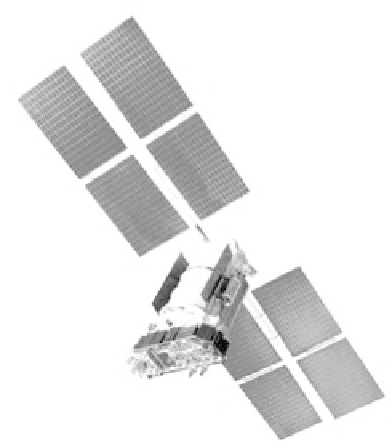Global Positioning System Reference
In-Depth Information
Like the original GLONASS spacecraft, the GLONASS-M spacecraft consists of
a pressurized, hermetically sealed cylinder that is three-axis stabilized. Figure 11.3 is
a depiction of the GLONASS-M spacecraft. By contrast, the solar panels are
attached to the top of the cylinder, and the payload assembly (attached on the bot-
tom of the spacecraft) is much larger in one dimension. The spacecraft mass will be
increased from the current satellite mass of approximately 1,300 kg to approxi-
mately 1,480 kg. This assembly consists of the horizon sensor, laser retroreflectors,
a 12-element navigation signal antenna, a cross-link antenna, and various command
and control antennas. The longer assembly allows the navigation payload and laser
retroreflector arrays to be mounted separately instead of interleaved. Attached to
the sides of the pressurized cylinder are the orbital correction engines, a portion of
the attitude control system, and the thermal control louvers [1, 9-12, 16-18].
11.1.6 Ground Support
The ground-based control complex (GBCC) is responsible for the following
functions [1]:
1. Measurement and prediction of individual satellite ephemeris;
2. Uploading of predicted ephemeris, clock corrections, and almanac
information into each GLONASS satellite for later incorporation into the
navigation message;
3. Synchronization of the satellite clocks with GLONASS system time;
4. Calculation of the offset between GLONASS system time and UTC (Soviet
Union);
5. Spacecraft command, control, housekeeping, and tracking.
The functions of the ground control segment had been performed by a number
of sites located within the former Soviet Union. With the demise of the USSR, the
Figure 11.3
GLONASS-M spacecraft.

Search WWH ::

Custom Search